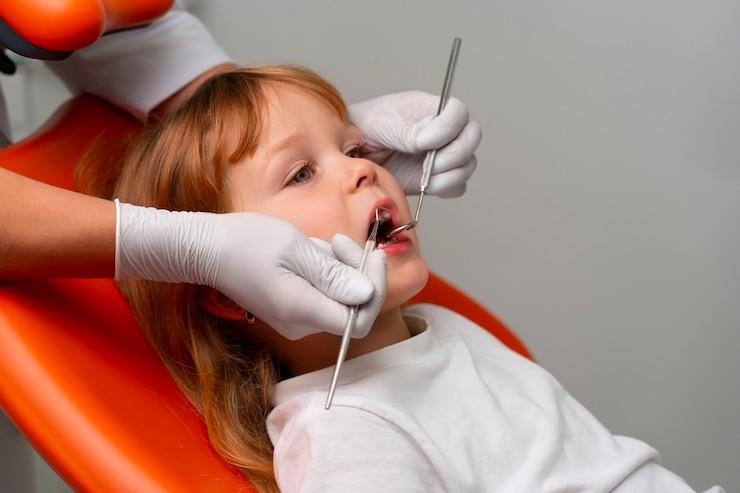From Baby Teeth to Braces: Your Child’s Complete Dental Timeline with MVP Smiles in Gaithersburg

Children’s oral health needs evolve with every stage of development—from the eruption of the first baby tooth to the application of braces in the teenage years. In Gaithersburg, MD, pediatric dentists focus on guiding families through this dental journey with care and clarity, helping ensure every child builds a healthy and confident smile that lasts into adulthood.
Understanding the dental timeline allows parents to stay informed and proactive about their child’s oral health. In this article, we outline the typical dental milestones children experience, when to schedule important visits, and what families can expect at each stage.
The First Year: Baby Teeth Begin to Appear
A child’s dental journey begins before their first birthday. Most infants start teething between 4 and 7 months, and by age 1, many will have their first few primary teeth.
Key points during this stage:
-
First dental visit: The American Academy of Pediatric Dentistry recommends scheduling a child’s first dental appointment by their first birthday or within six months of the first tooth erupting.
-
Oral hygiene habits: Parents should begin cleaning their baby’s gums with a soft cloth even before teeth appear, switching to a small toothbrush once teeth erupt.
-
Teething comfort: Sore gums are common. Chilled teething rings and gentle gum massages can help soothe discomfort.
Early visits help pediatric dentists monitor oral development and provide parents with essential guidance on cleaning, fluoride use, and nutrition.
Toddler Years: Establishing Healthy Habits
By age 2 to 3, children typically have a full set of 20 primary teeth. This is a critical time for building dental habits that will carry forward.
Important considerations:
-
Twice-daily brushing: Use a soft-bristled toothbrush and a pea-sized amount of fluoride toothpaste.
-
Diet and cavity prevention: Limit sugary drinks and snacks. Frequent snacking can increase the risk of tooth decay.
-
Fluoride treatments and sealants: Preventive care, including fluoride application and dental sealants for molars, may begin as recommended by the dentist.
At this stage, routine visits every six months are encouraged to catch early signs of decay and reinforce good oral hygiene.
Preschool to Early Elementary: Monitoring Development
Children ages 4 to 6 begin to gain more independence in brushing and flossing, though supervision is still essential. This age is also when dentists start assessing alignment and jaw development.
Dental milestones:
-
Tooth loss begins: Most children lose their first baby tooth around age 6.
-
Early orthodontic evaluations: Dentists may begin monitoring spacing, bite issues, and jaw alignment even before all permanent teeth erupt.
-
Speech and oral habits: Thumb-sucking or prolonged pacifier use can impact bite alignment and should be discussed with the dentist.
Pediatric dentists in Gaithersburg often use digital imaging and growth tracking tools to anticipate future needs.
Ages 6–12: Transition from Primary to Permanent Teeth
This is a dynamic phase of mixed dentition—where baby teeth fall out and permanent teeth come in. Children may feel self-conscious about gaps or crooked teeth, making dental care even more important.
What to expect:
-
Eruption of permanent teeth: Incisors, molars, and canines begin to emerge.
-
Sealants and preventive care: Molars may be protected with dental sealants to prevent decay in deep grooves.
-
Orthodontic considerations: Around age 7, a child should have an orthodontic evaluation to check for early signs of alignment issues or crowding.
Regular cleanings and monitoring help prevent common issues like cavities and gum inflammation as brushing habits evolve.
Adolescence: Orthodontics and Long-Term Maintenance
As most permanent teeth settle in during the teen years, orthodontic treatment often becomes a primary focus. This is also a time when dietary habits and oral hygiene can change—sometimes for the worse.
Focus areas:
-
Braces or aligners: Many teens begin orthodontic treatment between ages 11 and 14. Early intervention can reduce treatment duration and complexity.
-
Wisdom teeth monitoring: Panoramic X-rays help track the development of wisdom teeth and determine if removal is needed.
-
Lifestyle and hygiene: Sports participation may require mouthguards. Teens should be reminded to avoid sugary drinks and stay consistent with brushing and flossing.
Pediatric dental practices, including MVP Smiles in Gaithersburg, support teens through this transition with personalized care plans and education on long-term oral health habits.
How Pediatric Dentists Guide Families Through Each Stage
Pediatric dentists do more than treat teeth—they act as trusted partners in your child’s overall health. From infancy through adolescence, regular dental visits serve multiple purposes:
-
Monitoring growth and development
-
Providing age-specific preventive care
-
Educating parents and children
-
Intervening early to prevent future problems
By scheduling consistent dental check-ups, parents in Gaithersburg ensure their children receive timely care and expert guidance at every stage of their development.
MVP Smiles: A Local Example of Comprehensive Pediatric Care
In Gaithersburg, MVP Smiles offers a structured approach to pediatric dentistry that follows the complete dental timeline. Their team understands that each stage of childhood brings unique challenges and milestones. Through tailored preventive care, growth monitoring, and orthodontic evaluations, they support families from baby teeth to braces and beyond.
Their approach emphasizes consistency, education, and comfort—core values that help children develop confidence in their dental care.
Tips for Parents to Stay on Track
To make the most of each stage of your child’s dental timeline, consider these helpful tips:
-
Maintain a consistent dental visit schedule (every six months, or as recommended)
-
Reinforce brushing and flossing habits at home, even for older kids
-
Stay informed about what’s typical during each stage of oral development
-
Ask your pediatric dentist questions during visits to address concerns early
-
Encourage healthy dietary choices to reduce the risk of cavities
By staying proactive and informed, you can support your child’s oral health and make their dental journey a positive experience.
Final Thoughts
Understanding your child’s dental timeline—from the arrival of their first tooth to the day they get their braces removed—helps ensure they receive the right care at the right time. With guidance from pediatric dental professionals in Gaithersburg, families can confidently navigate every stage of oral development.
Practices like MVP Smiles provide structured, compassionate care designed to meet the needs of growing children. By focusing on prevention, education, and early intervention, they help lay the foundation for a lifetime of healthy smiles.







